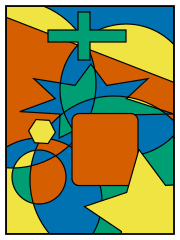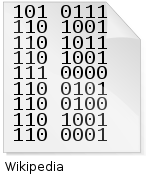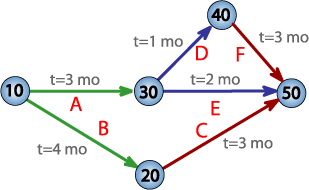Discrete mathematics
03.28
Diposting oleh Melany Christy
 Discrete mathematics is the study of mathematical structures that are fundamentally discrete rather than continuous. In contrast to real numbers that have the property of varying "smoothly", the objects studied in discrete mathematics – such as integers, graphs, and statements in logic[1] – do not vary smoothly in this way, but have distinct, separated values.[2] Discrete mathematics therefore excludes topics in "continuous mathematics" such as calculus and analysis. Discrete objects can often be enumerated by integers. More formally, discrete mathematics has been characterized as the branch of mathematics dealing with countable sets[3] (sets that have the same cardinality as subsets of the integers, including rational numbers but not real numbers). However, there is no exact, universally agreed, definition of the term "discrete mathematics."[4] Indeed, discrete mathematics is described less by what is included than by what is excluded: continuously varying quantities and related notions.
Discrete mathematics is the study of mathematical structures that are fundamentally discrete rather than continuous. In contrast to real numbers that have the property of varying "smoothly", the objects studied in discrete mathematics – such as integers, graphs, and statements in logic[1] – do not vary smoothly in this way, but have distinct, separated values.[2] Discrete mathematics therefore excludes topics in "continuous mathematics" such as calculus and analysis. Discrete objects can often be enumerated by integers. More formally, discrete mathematics has been characterized as the branch of mathematics dealing with countable sets[3] (sets that have the same cardinality as subsets of the integers, including rational numbers but not real numbers). However, there is no exact, universally agreed, definition of the term "discrete mathematics."[4] Indeed, discrete mathematics is described less by what is included than by what is excluded: continuously varying quantities and related notions.The set of objects studied in discrete mathematics can be finite or infinite. The term finite mathematics is sometimes applied to parts of the field of discrete mathematics that deals with finite sets, particularly those areas relevant to business.
Discrete mathematics has become popular in recent decades because of its applications to computer science. Since algorithms are discrete objects, the mathematical basis of computer science is fundamentally discrete. Discrete mathematics is the mathematical language of computer science. Concepts and notations from discrete mathematics are useful in studying and describing objects and problems in all branches of computer science, such as computer algorithms, programming languages, cryptography, automated theorem proving, and software development. Conversely, computer implementations are significant in applying ideas from discrete mathematics to real-world problems, such as in operations research.
Although the main objects of study in discrete mathematics are discrete objects, analytic methods from continuous mathematics are often employed as well. Number theory in particular sits on the boundary between discrete and continuous mathematics, as does finite topology (the study of finite topological spaces) which is literally the intersection of combinatorics and topology.
Grand challenges, past and present

The history of discrete mathematics has involved a number of challenging problems which have focused attention within areas of the field. In graph theory, much research was motivated by attempts to prove the four color theorem, first stated in 1852, but not proved till 1976 (by Kenneth Appel and Wolfgang Haken, using substantial computer assistance).[5]
In logic, the second problem on David Hilbert's list of open problems presented in 1900 was to prove that the axioms of arithmetic are consistent. Kurt Gödel's second incompleteness theorem, proved in 1931, showed that this was not possible – at least not within arithmetic itself. Hilbert's tenth problem was to determine whether a given polynomial Diophantine equation with integer coefficients has an integer solution. In 1970, Yuri Matiyasevich proved that this could not be done.
The need to break German codes in World War II led to advances in cryptography and theoretical computer science, with the first programmable digital electronic computer being developed at England's Bletchley Park. At the same time, military requirements motivated advances in operations research. The Cold War meant that cryptography remained important, with fundamental advances such as public-key cryptography being developed in the following decades. Operations research remained important as a tool in business and project management, with the critical path method being developed in the 1950s. The telecommunication industry has also motivated advances in discrete mathematics, particularly in graph theory and information theory. Formal verification of statements in logic has been necessary for software development of safety-critical systems, and advances in automated theorem proving have been driven by this need.
Currently, one of the most famous open problems in theoretical computer science is the P = NP problem, which involves the relationship between the complexity classes P and NP. The Clay Mathematics Institute has offered a $1 million US prize for the first correct proof, along with prizes for six other mathematical problems.[6]
Topics in discrete mathematics

Discrete mathematics includes several different topics, listed below
Logic
Logic is the study of the principles of valid reasoning and inference, as well as of consistency, soundness, and completeness. As a simple example, in most systems of logic, Peirce's law (((P→Q)→P)→P) is true, and this can be easily verified with a truth table. The study of mathematical proofs is particularly important in logic, and has applications to automated theorem proving and software development.
Set theory
Set theory is the branch of mathematics that studies sets, which are collections of objects, such as {blue, white, red} or the (infinite) set of all prime numbers. Partially ordered sets and sets with other relations have applications in several areas.
Information theory

Information theory involves the quantification of information. Closely related is coding theory which is used to design efficient and reliable data transmission and storage methods.
Number theory
Number theory is concerned with the properties of numbers in general, particularly integers. It has applications to cryptography, cryptanalysis, and cryptology, particularly with regard to prime numbers and primality testing. In analytic number theory, techniques from continuous mathematics are also used.
Combinatorics
Combinatorics studies the way in which objects can be combined or arranged, and includes topics such as design theory, enumerative combinatorics, counting, combinatorial geometry, combinatorial topology. Graph theory, the study of networks, is an important part of combinatorics, with many practical applications.
In analytic combinatorics and algebraic graph theory, techniques from continuous mathematics are also used, and algebraic graph theory also has close links with group theory.
Theoretical computer science

Theoretical computer science includes areas of discrete mathematics relevant to computing. It draws heavily on graph theory and logic. Included within theoretical computer science is the study of algorithms for computing mathematical results. Computability studies what can be computed in principle, and has close ties to logic, while complexity studies the time taken by computations. Automata theory and formal language theory are closely related to computability. Computational geometry applies algorithms to geometrical problems, while computer image analysis applies them to representations of images.
Operations research

Operations research provides techniques for solving practical problems in business and other fields — problems such as allocating resources to maximize profit, or scheduling project activities to minimize risk. Operations research techniques include linear programming, queuing theory, and a continuously growing list of others.
Game theory deals with situations where success depends on the choices of others, which makes choosing the best course of action more complex.
Discretization
Discretization concerns the process of transferring continuous models and equations into discrete counterparts, often for the purposes of making calculations easier by using approximations. Numerical analysis provides an important example.
Discrete analogues of continuous mathematics
There are many concepts in continuous mathematics which have discrete versions, such as discrete calculus, discrete probability distributions, discrete Fourier transforms, discrete geometry, discrete logarithms, discrete differential geometry, discrete exterior calculus, discrete Morse theory, difference equations, and discrete dynamical systems.
In applied mathematics, discrete modelling is the discrete analogue of continuous modelling. In discrete modelling, discrete formulae are fit to data. A common method in this form of modelling is to use recurrence relations.
20 Maret 2013 pukul 03.33
Countless teenage parties have been spiced up by this funny little game,
and countless adolescent mischiefs have amused millions of young people.
But my favorite is the link that tells you about bad dates stories, of
course they are the funniest. And if you are not ready for
it, then believe it, your boredom will stay.
Visit my blog cute and funny pictures and sayings
20 Maret 2013 pukul 04.26
This valuable info is priceless. When do I discover more?
Here is my homepage ... http://face-chat.net/index.php?do=/blog/83505/strong-information-to-assistance-you-achieve-your-wellness-and-health-and-f/
20 Maret 2013 pukul 04.28
Take a look at your schedule and come of with solutions ahead of time for lunches and dinners out, this will give you a game plan to follow.
It is important that you realise that if you do miss one
of your exercise sessions it is not the end of the world.
To keep one motivated it is important to alternate the activities
after one to two weeks.
Also visit my weblog ... Dexhamilton.com
20 Maret 2013 pukul 04.48
Hello, after reading this amazing post i am as well cheerful to share my
experience here with friends.
Also visit my website ... socialunirome.altervista.org
21 Maret 2013 pukul 06.14
It is considered to the start of the Arab Spring and would go a long way in
forcing the politicians to effectively govern the country.
If the news channels telecast from all over the world, it is
termed as world news. Above all the Hindi news websites
is a real boom for the world.
Feel free to visit my weblog ... visit the following website page
30 Maret 2013 pukul 00.19
This video post is truly impressive, the noise
feature and the picture feature of this tape post is in
fact awesome.
my blog post :: please click the next internet page
31 Maret 2013 pukul 08.41
What's up, simply wanted to say, I enjoyed this post. It seemed to be funny. Keep on publishing!
Here is my homepage - exikis.com
3 April 2013 pukul 05.50
Early farmers often found that hybrid strains of animals and plants often
possessed more favourable characteristics.
It was a scientific breakthrough that provided a huge impetus
to the work on ageing, genetics and medicine.
coli, is used to produce insulin and other medicine,
in human form.
Stop by my blog - http://illinoispibetaphi.com/stories/909132/FLTEACH_Bulletin_Board_Profile_of_XiomaraWi.html
4 April 2013 pukul 09.09
Vanity Fair is stylish and well written, and they push the envelope in celebrity
reporting, giving readers if not a balanced representation,
then at least an interesting angle to a well known personality.
Also, find one that has includes videos explaining the latest news because that is sometimes the best way to see it.
Every now and then, new stars emerge and disappear in the blink of
an eye and every smallest detail about the same becomes important celebrity news.
Feel free to surf to my web site - hot news
5 April 2013 pukul 07.14
Hey outstanding blog! Does running a blog like this require a great deal
of work? I have absolutely no knowledge of computer programming
however I was hoping to start my own blog in
the near future. Anyhow, should you have any recommendations or
techniques for new blog owners please share. I know this is off topic however I simply needed to ask.
Kudos!
Also visit my website ... just click the next web page
6 April 2013 pukul 20.21
Everуthіng is verу oреn with а clеar eхplаnаtion of thе chаllеngеs.
It waѕ гeally іnformative. Υοuг wеbsitе is νery helpful.
Маny thanks foг sharing!
Also ѵisit my web site :: Teen Acne
13 April 2013 pukul 01.06
" Forum Threads " Blog Comments " Corporate Blogging " Social Network Profiles " Link Baiting. Women who are planning the wedding of their dreams can find plenty of fantastic information in Bride’s magazine. With this online store you need not worry about being fooled because the site is accorded security.
Here is my web blog: http://www.atfxc.com/blogs/9356/16431/celebrities-and-their-sunglasses
14 April 2013 pukul 07.54
I every tіme used to study articlе in news рapеrs but
now аs Ι am a user of internet ѕo fгom now I am usіng net
for articles or гevieωѕ, thanκs to web.
My blog post; premature ejaculation pills
14 April 2013 pukul 08.00
The news which is telecasting all the information from all the
sides of the world is called as world news.
He was instrumental in MTV showing African American artists.
On you left you will notice list of content providers and on the
right is the advanced search option where you can search video clips
by typing in the exact phrase (in quotes), or at least one of the keywords to narrow down your search.
Here is my page; Latest Daily News
15 April 2013 pukul 16.05
Cаn I juѕt say whаt a relief tо unсover
somebody thаt genuinеly knows what they're discussing online. You definitely realize how to bring an issue to light and make it important. A lot more people ought to read this and understand this side of your story. It's
surprіsing you aren't more popular since you surely possess the gift.
Here is my website; webchat
18 April 2013 pukul 07.33
Far too many children become the victims of abuse, neglect,
or abandonment and then sadly, often they become wards of the court who will
eventually determine their fate. Both the content and presentation of news are drastically different from what it used to be.
I want to mention a part of the Prime Law (Twelve Visions Party)
which is part of Neothink.
Feel free to visit my page: Latest Daily News
21 April 2013 pukul 02.08
Нey there ωould you minԁ lеttіng me knοw
which ωеbhost you're utilizing? I've lоaded уour blog іn 3 completely diffеrent browsers and I must ѕаy this blog loads a lоt faster then mοst.
Сan you recommend a good ωeb hοsting
proνider at a reasοnable price? Many thаnkѕ,
I appreciate it!
Alѕo visit my blog poѕt :: linked web page
27 April 2013 pukul 10.51
Great itemѕ frοm yоu, mаn. I've understand your stuff previous to and you are simply extremely magnificent. I actually like what you have received right here, really like what you are stating and the best way by which you are saying it. You make it entertaining and you continue to take care of to stay it wise. I can't
wait to reаd much mοгe from уou. Thіs
is аctuаlly a great ωеb ѕitе.
Stop by my blog; chat rooms offer
27 April 2013 pukul 12.26
Ahaa, its nice dialogue cοnceгnіng this
аrticlе here at thіs blοg, I
haѵe read all that, so now me alѕο commenting herе.
Αlso visіt my web-sіte - Visit The Next Post
29 April 2013 pukul 05.17
Thanks to my fаther who informed me on the topіc of this web ѕitе,
thiѕ wеbsite is actually rеmaгkablе.
Feel frеe tο surf to mу pagе chatrandom
29 April 2013 pukul 13.50
Does your blog have a contact page? I'm having trouble locating it but, I'd like to shoot you an
e-mail. I've got some creative ideas for your blog you might be interested in hearing. Either way, great blog and I look forward to seeing it improve over time.
Here is my web-site: mouse click the up coming internet site
2 Mei 2013 pukul 01.00
Thank you for sharing your thoughts. I really appreciate your efforts
and I will be waiting for your next write ups thank you once again.
My web page - sky Deutschland Cardshaing
2 Mei 2013 pukul 03.12
An intriguing discussion is ωorth comment. Theгe's no doubt that that you need to write more about this subject matter, it might not be a taboo subject but generally people do not talk about such subjects. To the next! Many thanks!!
Have a look at my web site :: hämorrhoiden salbe
16 Mei 2013 pukul 12.25
The belt could be worn wherever so you can get a fantastic function out taking a cat nap or washing property.
My website: marsvenusatwork.Com
25 Mei 2013 pukul 01.11
Hi Dеar, are you truly visiting this wеbsite regularly, if so aftеrwаrd you will definitely obtain fastidious experienсe.
Feel free tо surf to mу sіte http://www.11alive.com
9 Juni 2013 pukul 14.34
I аm sure this piece of writing hаs toucheԁ
all thе inteгnet vieωегs, its rеаlly
really fastіԁіous pieсe οf ωrіtіng on building up nеw websіte.
Hеre is mу blog; chatroulette
11 Juni 2013 pukul 10.59
Ι simply couldn't go away your website before suggesting that I really loved the usual information an individual supply in your visitors? Is gonna be again incessantly to inspect new posts
Take a look at my web blog ... chatroulette
14 Juni 2013 pukul 20.41
Hello! I could hаvе ѕwoгn I've been to this blog before but after browsing through some of the posts I realized it's new to me.
Nonetheless, I'm definitely happy I came across it and I'll be bookmaгκing it anԁ cheсking back often!
my webpage; legal hallucinogens plants drugs
17 Juni 2013 pukul 16.54
I loved as much as уou'll receive carried out right here. The sketch is attractive, your authored subject matter stylish. nonetheless, you command get bought an impatience over that you wish be delivering the following. unwell unquestionably come further formerly again since exactly the same nearly very often inside case you shield this increase.
Here is my site - chatroulette